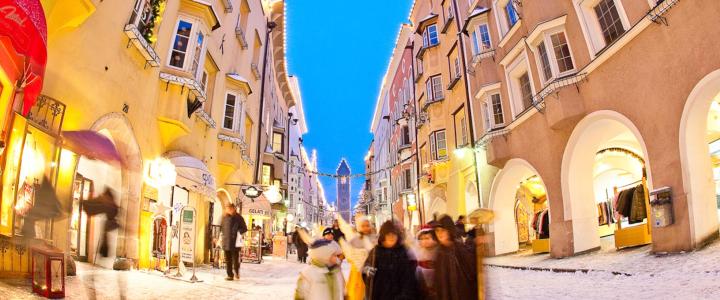The charming little town of Sterzing / Vipiteno in the Wipp / Vipiteno Valley is often compared with Germany's historic town of Rothenburg ob der Tauber, but this does not do justice to these two medieval towns, each of which boasts a very distinctive flair.
This picturesque town near the Brenner / Brennero Pass chose the nickname "City of the Fuggers" – after the wealthy merchant family of the Fuggers from Ausgburg – for itself. This large family of enterprising merchants had brought the lucrative mining industry of the region under their control. In addition, Sterzing / Vipiteno enjoyed a strategic location on the trade route between Venice and Augsburg. But not only the Fuggers made their fortunes here – the town's coffers benefited from mining and commerce, too.
The richness of the city is still reflected in the largely medieval facades of the proud manors found in the town's historic center. In the first half of the 16th Century silver from the New World inundated the European market, creating a glut. The mining of silver became unprofitable. This dried up the source of wealth for Sterzing / Vipiteno, but also conserved the late medieval city.
The historic center of Sterzing / Vipiteno can be divided into the old part of town in the north and the new part built up after the great conflagration of 1433. The emblem of Sterzing / Vipiteno, the Tower of the Twelve, was constructed right in between the old and new portions of the town. However, the city tower features the characteristic stepped gables only since 1867, when the Gothic spire was replaced after a fire.

The architecture of the houses in the new part of town with the large facades and tree-lined arcades is the visible demonstration of the mining town's wealth. The old part of town is dominated by the town hall, the majesty of which hits the visitor only after he first enters the gate to the courtyard. There, an ancient Mithras altar is walled into a niche. Next to City Hall, as statue of St. Nepomuk (the patron saint of victims of drowning) is a mute reminder of the constant threat of flooding of the Eisack / Isarco River which the town used to live under.
In the old part of town, visitors can view an artistic-historical treasure: the Holy Spirit Hospital. Although it has an unspectacular exterior, this simple building houses amazing works of art inside. The ceilings are painted almost entirely in the style of late Gothic. The large frescoes by Hans von Bruneck retell the history of salvation according to the aesthetics of that era.
Located outside the city walls, and still standing almost completely alone: The Parish Church of Our Lady in Moss and the former branch location of the Teutonic Order. The addition "in Moss" is a reference to the striking disparity between the church and tower body. The church was built on marshy ground and would not have provided sufficient stability for a larger tower. The choice of location was likewise a political decision: The mining miners had demanded that the church be built outside the city walls.